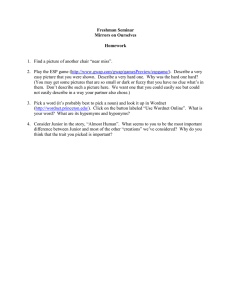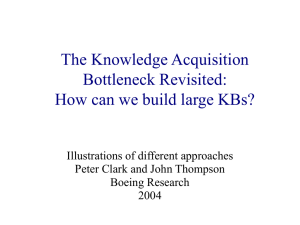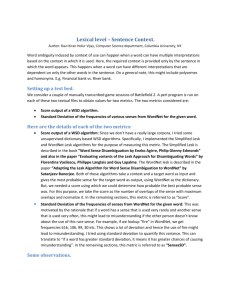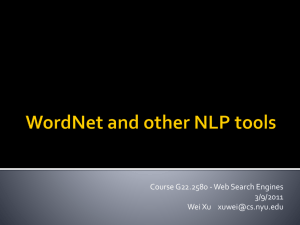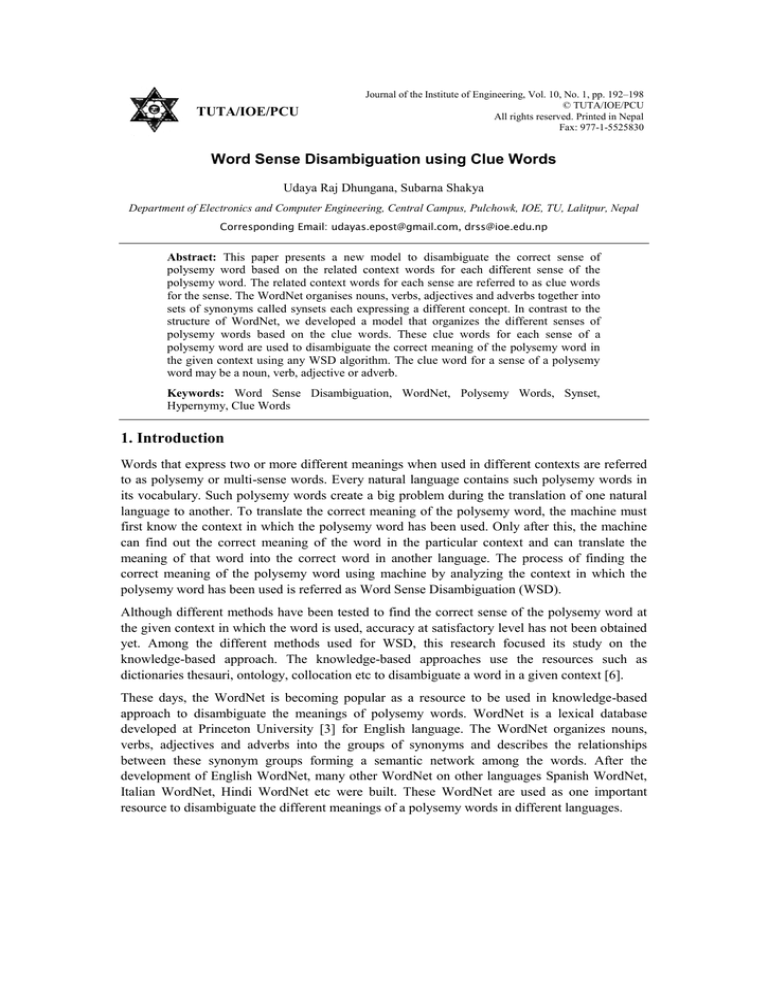
TUTA/IOE/PCU
Journal of the Institute of Engineering, Vol. 10, No. 1, pp. 192–198
© TUTA/IOE/PCU
All rights reserved. Printed in Nepal
Fax: 977-1-5525830
Word Sense Disambiguation using Clue Words
Udaya Raj Dhungana, Subarna Shakya
Department of Electronics and Computer Engineering, Central Campus, Pulchowk, IOE, TU, Lalitpur, Nepal
Corresponding Email: udayas.epost@gmail.com, drss@ioe.edu.np
Abstract: This paper presents a new model to disambiguate the correct sense of
polysemy word based on the related context words for each different sense of the
polysemy word. The related context words for each sense are referred to as clue words
for the sense. The WordNet organises nouns, verbs, adjectives and adverbs together into
sets of synonyms called synsets each expressing a different concept. In contrast to the
structure of WordNet, we developed a model that organizes the different senses of
polysemy words based on the clue words. These clue words for each sense of a
polysemy word are used to disambiguate the correct meaning of the polysemy word in
the given context using any WSD algorithm. The clue word for a sense of a polysemy
word may be a noun, verb, adjective or adverb.
Keywords: Word Sense Disambiguation, WordNet, Polysemy Words, Synset,
Hypernymy, Clue Words
1. Introduction
Words that express two or more different meanings when used in different contexts are referred
to as polysemy or multi-sense words. Every natural language contains such polysemy words in
its vocabulary. Such polysemy words create a big problem during the translation of one natural
language to another. To translate the correct meaning of the polysemy word, the machine must
first know the context in which the polysemy word has been used. Only after this, the machine
can find out the correct meaning of the word in the particular context and can translate the
meaning of that word into the correct word in another language. The process of finding the
correct meaning of the polysemy word using machine by analyzing the context in which the
polysemy word has been used is referred as Word Sense Disambiguation (WSD).
Although different methods have been tested to find the correct sense of the polysemy word at
the given context in which the word is used, accuracy at satisfactory level has not been obtained
yet. Among the different methods used for WSD, this research focused its study on the
knowledge-based approach. The knowledge-based approaches use the resources such as
dictionaries thesauri, ontology, collocation etc to disambiguate a word in a given context [6].
These days, the WordNet is becoming popular as a resource to be used in knowledge-based
approach to disambiguate the meanings of polysemy words. WordNet is a lexical database
developed at Princeton University [3] for English language. The WordNet organizes nouns,
verbs, adjectives and adverbs into the groups of synonyms and describes the relationships
between these synonym groups forming a semantic network among the words. After the
development of English WordNet, many other WordNet on other languages Spanish WordNet,
Italian WordNet, Hindi WordNet etc were built. These WordNet are used as one important
resource to disambiguate the different meanings of a polysemy words in different languages.
Word Sense Disambiguation using Clue Words
193
To disambiguate the meaning of a polysemy word using the WordNet, the related words from
synset, gloss and different levels of hypernym are collected from the WordNet database and
these related words are compared to find the overlaps using different WSD algorithm. However,
the collection of related words from synset, gloss and different level of hypernym that are taken
from the WordNet contains only very few words that can be used to disambiguate the correct
sense of a polysemy word in the given context (Dhungana U.R., 2008). This increases only the
computational overhead for the WSD algorithm and for the system. Moreover, according to
(Dhungana U.R., 2008), as we go increasing the levels of hypernym to collect the related words,
the sense of the words becomes more general and the two different sense of a polysemy word are
found to have the same hypernym. This therefore creates another ambiguity in ambiguity. To
overcome this problem, we have developed a new model to organize both the single sense and
multi-sense words.
2. Related Tasks
In [7], they have adapted original Lesk algorithm which was based on dictionary to use the
lexical database WordNet. They have used Senseval-2 word sense disambiguation exercise to
evaluate their system and found an overall accuracy of 32%. They have used a different counting
method for the words overlapping in their adapted algorithm. To compare two glosses, they have
used the longest sequence of one or more consecutive words that occurs in both glosses and for
each overlap, a square of the number of words in the overlap is calculated and taken the sum of
all overlaps.
In [5], authors had claimed that their work on automatic WSD using Hindi WordNet developed
at IIT Bombay was the first attempt for Hindi language. They used statistical method for
determining the senses and their system can disambiguate the nouns only. They have compared
the context of the word in a sentence with the contexts constructed from the WordNet and
choose the winner and evaluated their system on the Hindi corpora provided by the Central
Institute of Indian Languages (CIIL). The accuracy of their algorithm was found in the range
from 40% to 70%. They have used simple overlap method to determine the winner sense that is
the sense with highest overlaps in count is the sense determined by the system in the given
context.
In [9], authors have used overlap selection approach-the Lesk algorithm to disambiguate the
Nepali ambiguous words. They had modified the Lesk algorithm as: only the words in the
sentence as context words are compared with the glosses, examples and hypernym of the target
word whose meaning is to be disambiguated. They did not use the glosses, example and
hypernym of the context words to find the overlaps.
After the work of [9], Shrestha and Dhungana in [1], used the adapted Lesk algorithm with little
modification using the sample Nepali WordNet developed by themselves. The experiments
performed on 348 words (including the different senses of 59 polysemy words and context
words) with the test data containing 201 Nepali sentences shows the accuracy level is 88.05%,
which is found to be increased by 16.41%, in compared to the accuracy level of the earlier
research [9].
194
Journal of the Institute of Engineering
3. Statement of Research Problem
3.1
WSD and WordNet
From analyzing many research works on WSD using WordNet such as [4], [7], [5], [9] and [1],
it was noticed that the WordNet is not exactly suitable to use with knowledge-based, overlap
selection WSD approaches. The reason is that the WordNet is built for general purpose in NLP
tasks but not focused in WSD. In all WSD methods that used WordNet, the WordNet is used to
take a large number of words to disambiguate the meaning of multi-sense word. However, only
very few words taken from the WordNet are used to disambiguate the different senses of a multisense word. In this sense, all the efforts such as processing time for CPU and memory to store
large number of unused words are wasted. Furthermore, it is noticed that the words taken from
the WordNet to disambiguate the multiple meaning of the multi-sense word itself creates the
ambiguity resulting in decrease in accuracy.
Another important point noticed from [1] is that when deeper levels of the hypernymy from the
WordNet are used, the correctly disambiguated polysemy words are also incorrectly
disambiguated.
Now let us take an example which explains the problems that can be found in WordNet to use in
WSD methods. For this purpose, Hindi WordNet, which is same as the English WordNet in
structure with some modification to adapt the need of Hindi language, is taken.
3.1.1
Example: WSD and Hindi WordNet
Let us consider a polysemy word ताल (read as Taal) in Hindi language. In Hindi WordNet, the
word has eleven different meanings. The six meanings of the word ताल with the different levels
of hypernymy of each meaning are shown in figure 1. First look at the figure 1 (a) and (b). Here
we can see that the only the meaning of two different words are different. The hypernymy of the
two senses are the same except the meaning 2 have one more hypernymy. In such case, there is
no meaning of the use of the hypernymy of the two different senses of the polysemy word to
disambiguate their meanings. Inclusion of these hypernymy is just waste of computational effort
and waste of memory.
ताल
Meaning 1
Hypernymy
1
ताल
ेाान-ााचान -, बजाान आदि में उसकन समय और क्रिया का पररमाण ठीक
रखान का एक साधा “ाततकी वािक को ात्ृ य की ताल समझा रही है यह राे
/
तहा ताल का है ”
मााव कृतत, माावकृतत, माावकृतत-, मााव तार्मतत वस्तु, माावमााव -
बााय या तैयार की हुय वस्तु ावारा“यह मुेलकालीा मााव कृतत है ”
वस्तु, चहज़, चहज
"हवा एक
मर्तत वस्तु है "
वास्त वक या कय पत सत्ता -
यस्तत्व, मौजि
र् ेह, वज़ि
र् , वजि
र् , संभतर् त, वायमााता, सत्ता, हस्तह, भव,
ामोंताशाा
सत्ता का भाव -“कभहमें यह
ैया यावर का
यस्तत्व है ”
कृत वस्त-ु
ाा उठता है क्रक
यस्त,
कभह हमारन मा-
Word Sense Disambiguation using Clue Words
भाव
Hypernymy
2
195
वह यजसमें होान की क्रिया तादहत हो -“सुंिरता में सुंिर होान का भाव है”
बोध, संज्ञाा, ज्ञाा, भाा, संज्ञा, बोधध,
वबोध,
वेतत,
वेम,
वभास
वस्तत
ु ं -
मा या ववनक को होतह है और वायों की वह पर्णत जााकारी जो“कन्याकुमारी
में आत्मधचंता करतन समय स्वामह ववनकाांि को आत्म बोध हुआ”
(a) Meaning 1 of Word ताल
ताल
Meaning 2
Hypernymy 1
(is a kind of …..)
ताल - चामन कन कााँच का एक प ला "फ्रनम में ताल ठीक सन ाहीं बैठा है "
मााव कृतत, माावकृतत, माावकृतत-, मााव तार्मतत वस्त,ु माावकृत वस्त-ु -
मााव ावारा बााय या तैयार की हुय वस्तु "यह मुेलकालीा मााव कृतत है "
वस्तु, चहज़, चहज - वास्त वक या कय पत सत्ता "हवा एक
मत
र् त वस्तु है "
यस्तत्व, मौजि
र् ेह, वज़ि
र् , वजि
र् , संभतर् त, वायमााता, सत्ता, हस्तह, भव,
ामोंताशाा - सत्ता का भाव "कभहकभह- हमारन मा में यह
ैया यावर का
यस्त,
ाा उठता है क्रक
यस्तत्व है "
भाव - वह यजसमें होान की क्रिया तादहत हो "सुंिरता में सुंिर होान का भाव है "
(b) Meaning 2 of Word ताल
What we need is that the organization of the polysemy words must be in such a way that it must
only contains only such words in a efficiently organized way that these words are sufficient to
disambiguate the different senses of the polysemy word.
Table 3. 1: The different three senses of Hindi word ताल with their hypernymy.
ताल
Meaning 3
Hypernymy 1
(is a kind of …..)
तालाब, ताल, पोखरा, सरोवर, सर, तडाे, पोखर, तलाब, पुष्कर,
रकासार, ज ला,
तोयाधार, पुष्कररणह, पुखर - पााह का बडा कंु ड " धधक ेरमह कन कारण इस
तालाब का पााह सख
र् रहा है तालाब में रं ेहा कमल ेंखलन हुए / हैं"
जलाशय,
खात, झाताकनत, जलाकर, महाेोधधका, ह्रि, पर्त, आबेहर, पपतरीक -
वह स्थाा जहााँ पााह जमा होकर ठहरा या बाा रहता हो "जलाशय में कमल
ेंखलन हुए हैं"
स्थाा, जेह, स्थल, िन श, आेार, कनता, तािमण, ेाध, आस्थाा, आस्पि, इलाका,
इलाका, ततष्ठाा - तायाचत और पररर्मत यस्थततवाला वह भर्भाे यजसमें कोय बस्तह, ाकृततक रचाा या कोय वशना बात हो "काशह दहन्ित
ु ं का धार्मतक
स्थाा है
भभाे
-, भर्त्रनक्ष-, भौेोर्लक त्रनक्ष, भर्भाे - पथ्
र्
ृ वह का कोय बडा भाे या त्रनक्ष
196
Journal of the Institute of Engineering
"भारत एक ऐसा भभाे
है-, जहााँ ाााा
र्
कार की भाााएाँ बोली जातह हैं "
त्रनक्ष, इलाका, इलाका, िन श, ांत, ान्त, भर्र्म, ियार, फी ड - जमहा का एक भाे
"ग्रामहण त्रनक्षों में
H1
भह भह बबजली की समस्या बाह हुय है "
वस्तु, चहज़, चहज - वास्त वक या कय पत सत्ता "हवा एक
मर्तत वस्तु है "
यस्तत्व, मौजि
र् ेह, वज़ि
र् , वजि
र् , संभतर् त, वायमााता, सत्ता, हस्तह, भव,
ामोंताशाा - सत्ता का भाव "कभहकभह- हमारन मा में यह
ैया यावर का
यस्त,
ाा उठता है क्रक
यस्तत्व है "
भाव - वह यजसमें होान की क्रिया तादहत हो "सुंिरता में सुंिर होान का भाव है "
खंड, खण्ड,
H2
चरण,
ंश, टुकडा, भाे, दहस्सा,
ंशक, भंे - उा
ंेों या
ंे, वभाे, पुरज़ा, पुरजा, पुज़ात, पुजात, कल,
वयवों में सन कोय एक, यजाकन योे सन कोय
वस्तु बाह हो "इस यंक्ष कन सभह खंड एक ही यंक्षालय में बान हैं इसकन
ेलन
/
चरण में हम आपको एक ााटक दिखलाएाँेन"
भाे, दहस्सा,
ंश, वधा, भाे - समयष्ट
मध्य भाे कुछ मोटा है "
थवा समर्ह का कोय
ंश "इसका
यस्तत्व, मौजर्िेह, वज़र्ि, वजर्ि, संभर्तत, वायमााता, सत्ता, हस्तह, भव,
ामोंताशाा - सत्ता का भाव "कभहकभह- हमारन मा में यह
ैया यावर का
यस्त,
ाा उठता है क्रक
यस्तत्व है "
भाव - वह यजसमें होान की क्रिया तादहत हो "सुंिरता में सुंिर होान का भाव है "
(c) Meaning 3 of Word ताल
4. Problem Statement
Although WordNet is very useful lexical resource that can be used to disambiguate the different
meanings of a polysemy word, it has still some limitations discussed on previous section.
Therefore, to improve the accuracy of the knowledge-based overlap selection WSD methods
dramatically, we have extremely need of a new logical model that could organize the words in
such a way that it could disambiguate the meanings of a polysemy word correctly and efficiently
resulting in higher accuracy than that can be obtained from the use of WordNet.
5. Solution
Unlike in WordNet, we organized the different senses of polysemy word and grouped them
based on to which verb, noun, adverb, adjective, article, preposition etc each sense of a
polysemy word generally used with, the resulting model (a new WordNet like structure but
focused on WSD) contains all the necessary words/information that can sufficiently
disambiguate each meaning of a polysemy word. The new model does not contain any
unnecessary words/information which could itself again create ambiguity like WordNet.
Word Sense Disambiguation using Clue Words
197
For instance, a sample organization of different meanings of a polysemy word कडा in Nepali
language can be as shown in figure 2. The polysemy word कडा has five different meanings [8]
as shown in figure 3.
Table 3. 2: A sample organization of different meanings of a polysemy word कडा
Polysemy
Word
Used with verb
Used with noun
Used with
adjectives
कडा १
लेाउाु, पदहराु
ााडह, खुट्टा, स्क्षह, ाारी, चाड, पवत, तहज,
पहेँलो, सनतो,
कडा २
झन्
ु ्याउाु, समाउाु
कराय, ताउलो, ताउली, भााँडा, बतता, भान्छा
Experiment Settings
To check our new model, we set up the two experiments. In first experiment, we used the system
developed by [2] using the normal sample Nepali WordNet. In second experiment, we only
replaced the normal sample Nepali WordNet by our new model WordNet organized with clue
words keeping all the settings constant.
6. Result and Discussion
After running the experiments, we found that the system with normal sample Nepali WordNet
correctly disambiguated the polysemy words for 177 out of 201 test sentences. This shows the
accuracy of the system with normal sample Nepali WordNet to be 88.059%. In the second
experiment, the same system with our new model WordNet correctly disambiguated the
polysemy words for 184 out of 201 test sentences. At this time, the accuracy of the system is
found to be 91.543%. Using our new model WordNet that is specific to WSD is found to be
increased by 3.484%.
Table1: Experiments Results
Experiment No.
No of polysemy words
that are correctly
Disambiguated
No of polysemy words
that are not correctly
Disambiguated
Accuracy in
percentage
1
177
24
88.059
2
184
17
91.543
7. Conclusions
The WordNet organizes the words in the lexical database based on their meanings of the words
instead of their forms as in dictionaries. It groups the nouns, verbs, adjectives and adverbs
together into synonym sets, each expressing a distinct concept [10]. The words in a synonym set
can be interchangeably used in many contexts. The main relationship among the words in
WordNet is the synonym.
198
Journal of the Institute of Engineering
From analyzing many research works on WSD using WordNet such as [4], [7], [5], [9] and [1],
we have noticed that the WordNet is not exactly suitable to use with knowledge-based, overlap
selection WSD approaches. The reason is that the WordNet is built for general purpose in NLP
tasks but not focused in WSD. In all WSD methods that used WordNet, the WordNet is used to
take a large number of words to disambiguate the meaning of multi-sense word. But it is noticed
that only very few words taken from the WordNet are used to disambiguate the different senses
of a multi-sense word. In this sense, all the efforts such as processing time for CPU and memory
to store large number of unused words are wasted. To defeat with these problems of WordNet,
we developed a new model to mainly to organize the different senses of polysemy words using
the clue word rather than using the hypernym relations or any other relation from the WordNet
to disambiguate the sense of polysemy words. The experiments show that the accuracy of the
system using our new model WordNet is found to be 91.543%.
Acknowledgements
We would like to kindly express our sincere thanks to Madan Puraskar Pustakalaya (MPP) for
providing Nepali corpus. We are equally thankful to Mr. Balram Prasain, Lecturer, Tribhuwan
University for his valuable help in this research.
References
[1]
Dhungana, U. R. (2011). Nepali Word Sense Disambigution using Adapted Lesk Algorithm.
[2]
Dhungana, U. R. (2012). Nepali WSD Specific WordNet. Pokhara: Pokhara Engineering College.
[3]
George Armitage Miller, C. F. (n.d.). Wordnet. Retrieved June 12, 2012, from Princeton University:
http//:wordnet.princeton.edu/wordnet/
[4]
Lesk, M. (1986). Automatic Sense Disambiguation Using Machine Readable Dictionries: How to Tell a
Pine Cone from an Ice Cream Cone.
[5]
Manish Sinha, M. K. Hindi Word Sense Disambiguation.
[6]
Nancy Ide, J. V. (1998). Word Sense Disambiguation: The State of the Art.
[7]
Pedersen, S. B. An Adapted Lesk Algorithm for Word Sense Disambiguation using WordNet.
[8]
Sharma, B. K. (BS 2064). Samchhipta Nepali Sabdasagar. Sabdartha Prakashan .
[9]
Shrestha N., H. P. (2008). Nepali Word Sense Disambiguation Using Lesk Algorithm.
[10]
WordNet A Lexical Database for English. (n.d.). Retrieved Dec 4, 2013, from What is WordNet?:
https://wordnet.princeton.edu/wordnet/

